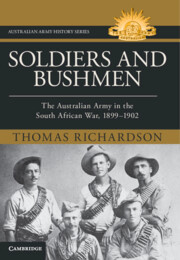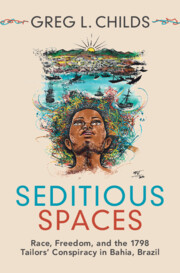Refine search
Actions for selected content:
63 results
8 - Warriors, Civilians, and the Spirit of Nationalism
-
- Book:
- Nationalism as a Way of Life
- Published online:
- 11 December 2025
- Print publication:
- 11 December 2025, pp 239-258
-
- Chapter
- Export citation
9 - From Deep Comradeship to Nationalist Subjectivities
-
- Book:
- Nationalism as a Way of Life
- Published online:
- 11 December 2025
- Print publication:
- 11 December 2025, pp 259-281
-
- Chapter
- Export citation
Chapter 6 - Counterinsurgency
-
- Book:
- Soldiers and Bushmen
- Published online:
- 29 July 2025
- Print publication:
- 06 August 2025, pp 147-172
-
- Chapter
- Export citation
Chapter 8 - Conclusion
-
- Book:
- Soldiers and Bushmen
- Published online:
- 29 July 2025
- Print publication:
- 06 August 2025, pp 198-201
-
- Chapter
- Export citation
Chapter 5 - Combat
-
- Book:
- Soldiers and Bushmen
- Published online:
- 29 July 2025
- Print publication:
- 06 August 2025, pp 120-146
-
- Chapter
- Export citation
Chapter 2 - The Australian Army in South Africa
-
- Book:
- Soldiers and Bushmen
- Published online:
- 29 July 2025
- Print publication:
- 06 August 2025, pp 35-71
-
- Chapter
- Export citation
Chapter 1 - Raising Australia’s Army
-
- Book:
- Soldiers and Bushmen
- Published online:
- 29 July 2025
- Print publication:
- 06 August 2025, pp 10-34
-
- Chapter
- Export citation
Chapter 3 - Command
-
- Book:
- Soldiers and Bushmen
- Published online:
- 29 July 2025
- Print publication:
- 06 August 2025, pp 72-96
-
- Chapter
- Export citation
Introduction
-
- Book:
- Soldiers and Bushmen
- Published online:
- 29 July 2025
- Print publication:
- 06 August 2025, pp 1-9
-
- Chapter
- Export citation
Chapter 4 - Morale
-
- Book:
- Soldiers and Bushmen
- Published online:
- 29 July 2025
- Print publication:
- 06 August 2025, pp 97-119
-
- Chapter
- Export citation
Chapter 7 - Coercion
-
- Book:
- Soldiers and Bushmen
- Published online:
- 29 July 2025
- Print publication:
- 06 August 2025, pp 173-197
-
- Chapter
- Export citation

Soldiers and Bushmen
- The Australian Army in South Africa, 1899–1902
-
- Published online:
- 29 July 2025
- Print publication:
- 06 August 2025
Chapter 16 - Bullets, Guns, and Tattoos
- from Part IV - Form
-
-
- Book:
- Latinx Literature in Transition, 1848–1992
- Published online:
- 10 April 2025
- Print publication:
- 17 April 2025, pp 277-294
-
- Chapter
- Export citation
The Battlefield Experience of Japanese Soldiers in the Asia-Pacific War
-
- Journal:
- Asia-Pacific Journal / Volume 18 / Issue 19 / October 2020
- Published online by Cambridge University Press:
- 14 March 2025, e2
-
- Article
-
- You have access
- Open access
- Export citation
Clever enough to tell the truth
-
- Journal:
- Experimental Economics / Volume 20 / Issue 1 / March 2017
- Published online by Cambridge University Press:
- 14 March 2025, pp. 130-155
-
- Article
- Export citation

Seditious Spaces
- Race, Freedom, and the 1798 Tailors' Conspiracy in Bahia, Brazil
-
- Published online:
- 06 March 2025
- Print publication:
- 13 March 2025
Chapter 8 - Making Soldiers Count
-
-
- Book:
- Nineteenth-Century Literature in Transition: The 1850s
- Published online:
- 02 January 2025
- Print publication:
- 16 January 2025, pp 179-200
-
- Chapter
- Export citation
PUDENS, OPTIO CARCERIS: ROMAN MILITARY FIGURES AND THEIR NARRATIVE FUNCTION IN THE PASSION OF PERPETUA AND FELICITAS
-
- Journal:
- The Classical Quarterly / Volume 74 / Issue 2 / December 2024
- Published online by Cambridge University Press:
- 24 April 2025, pp. 691-707
- Print publication:
- December 2024
-
- Article
-
- You have access
- Open access
- HTML
- Export citation
Introduction - “Almost Enough to Make Cowards of the Bravest Men”
-
- Book:
- Dread Danger
- Published online:
- 07 November 2024
- Print publication:
- 21 November 2024, pp 1-12
-
- Chapter
- Export citation
Military Instrumentality in Rhodesia and Zimbabwe - Black Soldiers in the Rhodesian Army: Colonialism, Professionalism, and Race M. T. Howard. Cambridge: Cambridge University Press, 2024. Pp. xvi+282. $110.00, hardcover (ISBN: 9781009348447).
-
- Journal:
- The Journal of African History / Volume 65 / Issue 2 / July 2024
- Published online by Cambridge University Press:
- 20 November 2024, pp. 279-281
-
- Article
- Export citation
